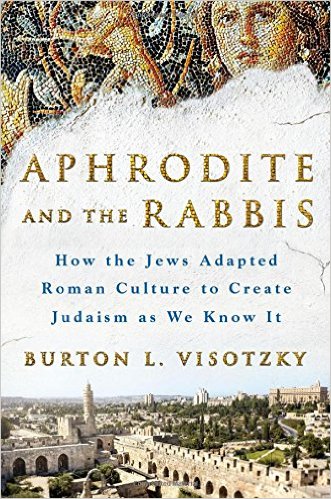Chains of tradition buttressing the right to rule the school were commonplace among the Greek philosophers.
Each of these “chains” shares an odd common trait with the others: no matter what the actual chronology may be, each chain of tradition is fourteen links from the founder to the newest head of the academy.
It does not make any difference whether those fourteen generations took one hundred years or five hundred years— accuracy in counting years is not the point. Getting from the newest head of the academy back to the founder of the school in but fourteen links is what it’s all about.
This oddity also can be observed in the New Testament, where Jesus’s lineage is traced in groups of fourteen (father to son, rather than teacher to disciple). And were we to laboriously count out the chain from Moses at Sinai to Rabbi Yohanan and his disciples, we’d get the same magic number: fourteen. No one knows why fourteen seems to be the “correct” number of links, but Pirke Avot joins with all the philosophical schools in tracing its newest leader’s lineage back to the founder in fourteen generations.
Visotzky, Burton L.. Aphrodite and the Rabbis: How the Jews Adapted Roman Culture to Create Judaism as We Know It (Kindle Locations 2037-2045). St. Martin’s Press. Kindle Edition. (My formatting and highlighting)
Now that’s an intriguing mystery. Here is a truncated portion of the opening two chapters of that Mishnah tractate, Pirke Avot (=Chapters of the Fathers):
- Moses received the Torah from Sinai and gave it over to Joshua.
- Joshua gave it over to the Elders,
- the Elders to the Prophets,
- and the Prophets gave it over to
- the Men of the Great Assembly. . . .
- Shimon the Righteous was among the last surviving members of the Great assembly. . . .
- Antignos of Socho received the tradition from Shimon the Righteous. . . .
- Yossei the son of Yoezer of Tzreidah, and Yossei the son of Yochanan of Jerusalem, received the tradition from them. . . .
- Joshua the son of Perachia and Nitai the Arbelite received from them. . . .
- Judah the son of Tabbai and Shimon the son of Shotach received from them. . . .
- Shmaayah and Avtalyon received from them. . . .
- Hillel and Shammai received from them. . . .
- Rabban Yochanan the son of Zakkai received the tradition from Hillel and Shammai. . . .
- Rabban Yochanan the son of Zakkai had five disciples: Rabbi Eliezer the son of Hurkenus, Rabbi Joshua the son of Chananya, Rabbi Yossei the Kohen, Rabbi Shimon the son of Nethanel, and Rabbi Elazar the son of Arach.
We all know about the curious genealogy in the Gospel of Matthew and the way it points out the fourteen-fold division of the line from Abraham to Jesus:
Matthew 1:17 — Thus there were fourteen generations in all from Abraham to David, fourteen from David to the exile to Babylon, and fourteen from the exile to the Messiah.
I would be very interested to see examples of the fourteen teachers/pupils links among the Greek philosophical schools.
Is there anyone who can help locate instances of that tradition?
If you enjoyed this post, please consider donating to Vridar. Thanks!


I don’t know of any off-hand. But it strikes me that this use of the number ’14’ for these chains may well come out of something like ‘sacred’ or Pythagorean geometry. One gets the impression that in the ancient world given concepts like the ‘harmony of the spheres’ and so on, basic geometry was integrated into their worldview in a way not possible for us today. It was an intrinsic part of their cognitive overlay, so to speak. It wouldn’t surprise me if ’14’ weren’t derived from some elementary geometrical or arithmetical operation, and in a way akin to the harmony of the spheres concept, it was thought that on account of this, there just ‘had’ to be 14 generations between origin and most recent point. – Just a speculation.
Eusebius has 14 generations of of perfect bishops of the circumcision in the Jerusalem Church after Jesus. Actually with James as the first Bishop there are fifteen, but James is of the same generation as Jesus and so is his successor Symeon who is the son of Clopas, the brother of Jesus’ father Joseph. Since Symeon and James are from the same generation as Jesus, there are only 14 generations, although 15 names. James may have been a late addition to Eusebius’ list done for political reasons relating to Constantine. (Church History 4.5)
Eusebius then has 14 more generations, these of non-circumcised Bishops of Jerusalem.
1) Marcus, 2) Cassianus, 3) Publius, 4) Maximus, 5) Julian, 6) Gaius, 7) Symmachus, 8) Gaius, 9) Julian, 10) Capito, 11) Valens, 12) Dolichianus, 13) Narcissus (Church History, 5.14) ( there is confusion with Dius, Germanio and Gordius being named successors, but, apparently Narcissus had disappeared and was only thought dead and then Narcissus returns from the dead to resume his bishopic. His successor is Alexander. Dius, Germanio and Gordius should probably count as the same generation as Narcissus.) 14. Alexander (Church History, 6.11)
Then comes the Bishops of Eusebius’ time.
1) Mazabanes (6.39.3) 2) Hymenæus (7.14) 3) Zambdas 4) Hermon (7.29).
Perhaps Eusebius was leaving ten more generations until the end of the world, or perhaps seven if we include Dius, Germanio and Gordius being later generations.
And Irenaeus in Against Heresies 3.3 has the “true church” tracing 14 generations from Jesus to his own day:
Jesus
Peter and Paul
Linus
Anacletus
Clement
Evaristus
Alexander
Sixtus
Telephorus
Hyginus
Pius
Anicetus
Sorer
Eleutherius (contemporary of Irenaeus)
Still keeping an eye-out for the philosophical schools.